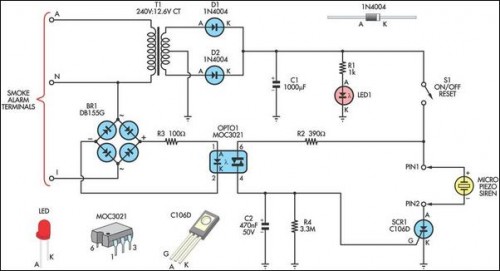- Remote Alarm For Smoke Detector
- Powerful Security Siren
- Mini Alarm
- Laptop Protector
- Bell Alarm
- A 5-Digit Alarm Control Keypad
- A 4-Digit Alarm Control Keypad
- A Battery-Powered One-Time-Only Burglar Alarm
- An Enhanced Shed / Garage Alarm
- A Shed / Garage Alarm
- A Simple Fire-Door Alarm
- A Simple Shop-Door Alarm
- Four Small Transistor Alarm Circuits
- A Dozen Small Cmos Alarm Circuits
- A Cmos 4060 Burglar Alarm
Remote Alarm For Smoke Detector
Description
This alarm circuit was designed to monitor a mains-powered smoke detector located in a shed (which is used to house dog kennels). It provides complete isolation from the mains so that low-voltage (12V) cabling could be run to the alarm circuit which is located inside the house. In operation, the alarm signal (I) from the smoke detector is rectified using bridge rectifier BR1 and then fed to optoiso lator OPTO1 via resistor R3. This in turn drives the gate of SCR1 which turns on and activates a piezo siren with inbuilt oscillator.
Power for the circuit is derived via mains transformer T1. This drives a full-wave rectifier based on diodes D1 & D2 to produce around 9V DC and this is then applied to the alarm cir cuit via switch S1. Capacitor C1 filters the supply rail, while LED1 provides power-on indication. When the alarm is triggered, it latches on until reset by S1 (ie, the switch must be opened and then closed again). Finally, a relay could be connected between pins 1 & 2 to switch larger loads than the piezo siren - eg, to turn emergency lights on.
Circuit diagram:
Note:
This circuit is recommended for experienced constructors only. In particular, note that all parts to the left of the MOC3021 optocoupler, including BR1 and R3, are at mains (240VAC) potential.
circuit from http://www.extremecircuits.net/2010/05/remote-alarm-for-smoke-detector.html
